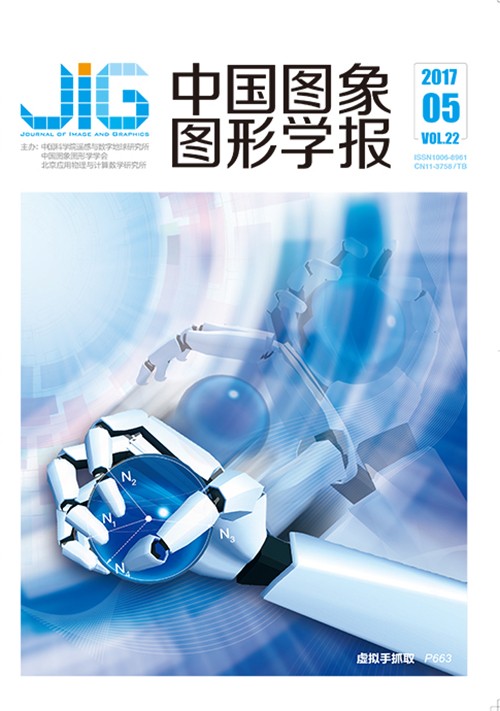
适应物体形状的虚拟手抓取
摘 要
目的 虚拟手抓取是虚拟交互中的核心技术之一,直接影响沉浸感。已有的虚拟手抓取规则基于接触点法矢夹角和接触点与体心连线的夹角,但在部分形状上不能正确抓取。为此提出一种适应物体形状的抓取规则。方法 针对长方体、球、圆柱这些构成物体的基本几何体,利用形状特征和手指抓握的接触关系制定抓取规则:1)长方体的规则是至少有3个不共线的接触点,并且一对接触点法矢夹角超过90°;2)球的规则要对接触点和球心的空间关系进行计算;3)圆柱的规则根据接触点是否在曲面上,使用长方体规则,或是仿照球的规则判断。对于需要使用多个几何体描述外形的复杂物体,先按照这3种基本几何体分解、单独计算,然后筛选出其中不稳定状态的几何体,把整体的接触点位置、法矢信息集中在这些不稳定状态几何体上,用单一几何体的抓取规则计算整体的抓取。同时加入力矩平衡可能性的计算,抓取规则和力矩平衡二者都满足才判定抓取成功,进一步减少了错误判断的发生。结果 使用unity3d构建虚拟场景,并用neuron的数据手套采集人体、手指数据,进行虚拟交互的仿真。该方法可以正确处理类似水杯这样的多几何体组合物体的抓取判断。结论 本文提出了基于物体形状的抓取规则,和用简单基本形状分解复杂物体的计算方法,准确计算抓取,符合直观感受。
关键词
Shape-adaptive virtual hand-grasping method
Hu Chen, Zhang Xuedan, Ma Huimin(Tsinghua University, Beijing 100084, China) Abstract
Objective Virtual hand grasping is one of the core topics/techniques in virtual interaction, and it strongly determines the immersion. Given that real-time force analysis is complex, considerable rules that meet the characteristics of hand grasping are formulated instead of complex mechanic calculations. Some existing rules focus on the included angle of the normal vector of two contact points or the included angle of two lines that connect contact point and object center, but they cannot deal correctly with some shapes. This study proposes a shape-adaptive grasping method. Method This method uses the shape features and contact points of basic geometries, such as cube, sphere, and cylinder, to design grasping rules. 1) For a cube, at least three contact points that are not all collinear must be on the surface, and one of the included angles of the normal vector of every two contact points is larger than 90°. First, the positions of all contact points are determined. Second, the cube and all points are rotated; thus, every edge of the cube is parallel to the world axis, which simplifies the calculation. Third, whether the location of every point is on the plane, edge, or vertex of the cube is determined by the cube scale. Fourth, the normal vector of these points is calculated based on their locations. The vector direction is perpendicular to the plane when the point is on the plane or is the same as the moving direction of the point when the point is on the edge or vertex. Finally, the included angles of every two normal vectors are calculated, and the grasping result is determined. 2) For a sphere, at least four contact points exist, and the spatial relationship between these points and the sphere center should satisfy the proposition obtained from the analysis. First, the positions of the sphere center and all contact points are identified. Second, the center and every two of these points are used to form a plane, and whether all other points are on the same side of this plane is calculated. Finally, the grasping result is determined with the calculation results. 3) For a cylinder, depending on whether the contact points are all on the curved surface, a rule similar to sphere rule is used. First, the positions of all contact points are determined, and the cylinder and all the points are rotated so that the bottom plane of the cylinder parallels the world axis. Second, these points are projected to the bottom plane of the cylinder. Third, the circle center of the bottom plane and every projected point are used to form a diameter, and whether all other projected points are on the same side of the diameter is calculated. Finally, the grasping result is generated with the calculation results. When points exist on the top or bottom plane, the cube rule is used instead. Result This method can realistically handle the grasping of an object with a curved surface. For a complex object that can be composed by multiple basic geometries, our method divides the calculation into two steps. First, the object is decomposed into three basic geometries and then each geometry is calculated separately. Some geometries nearly meet the grasping rule, called unstable state. Second, our method selects each of these unstable state geometries, gathers information, such as the position and normal vector of all the points to it, and makes decisions on whether the entire object is caught with the basic geometry rules obtained before. Calculating the possibility of moment balance further reduces the occurrence of erroneous determinations. All normal vectors are the opposite direction of force, but their values are uncertain. The proposition obtained from the analysis implies that the moment may balance when the normal vectors meet a specific spatial relationship similar to the sphere rule. First, all normal vectors are normalized and projected to a unit sphere; thus, points exist on the surface. Second, the points are used to calculate the same proposition in sphere rule. Finally, whether the moment is balanced is determined. Only when both rules and moment balance are satisfied will the grasping be determined as a success. Experimental results show that the method can effectively handle the grasp of objects with curved surfaces, such as balls, and complex objects, such as cups, by using Unity3d software and Neuron Data Glove. When the virtual hand touches the upper hemisphere, the ball is not caught. Only if the figures ring around the ball will it be caught; casually grasping the cup will not catch it. Only when the gesture is correct and the moment is balanced can the cup be caught. Conclusion This study proposes a shape-adaptive grasping method and a calculation method that decomposes complex objects into simple basic geometries. This method effectively handles the grasp and conforms to intuitive feel.
Keywords
|



 中国图象图形学报 │ 京ICP备05080539号-4 │ 本系统由
中国图象图形学报 │ 京ICP备05080539号-4 │ 本系统由